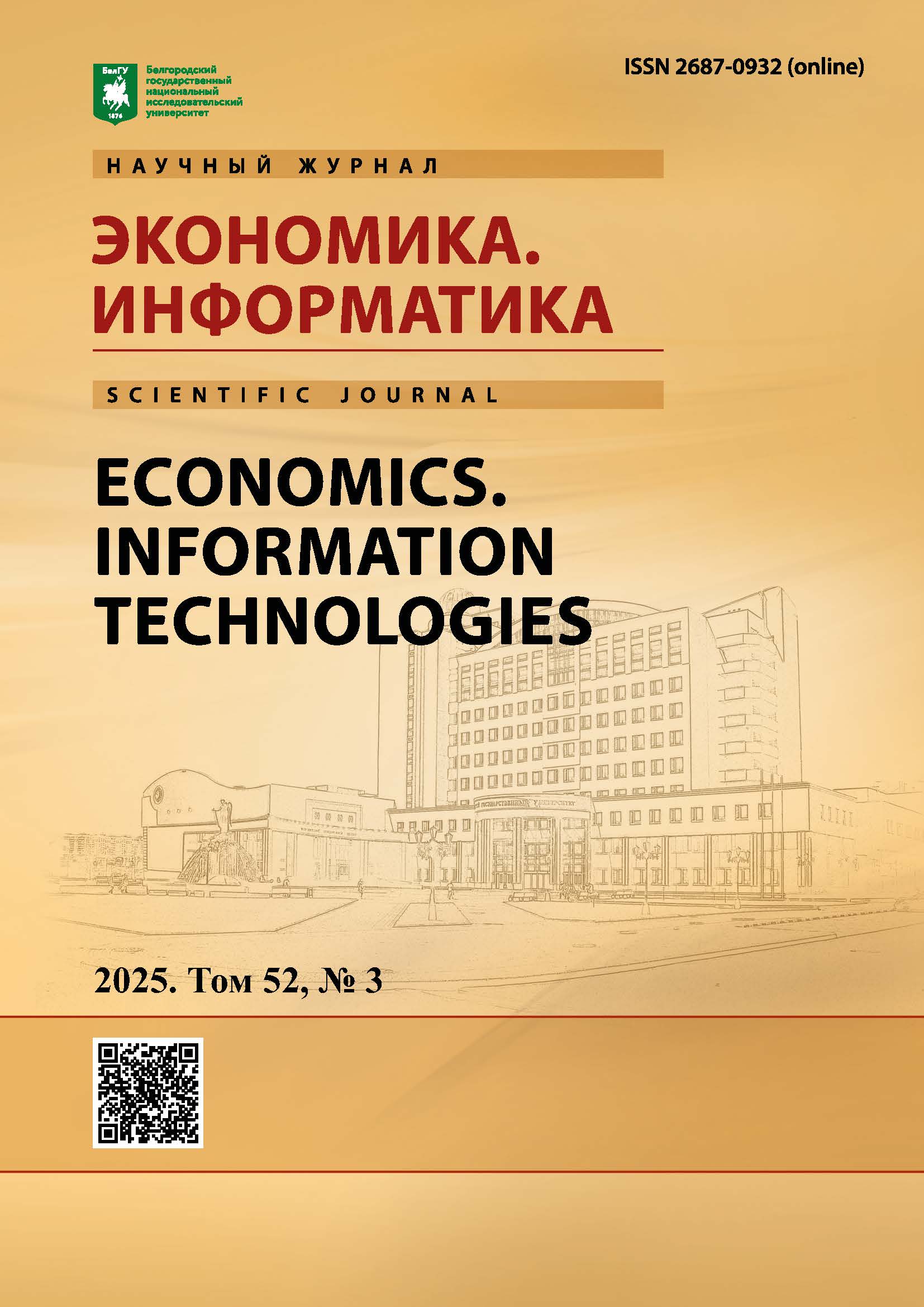Methodological Tools for Identifying Town Development Priorities Based on Matrices of Sectoral Innovation and Technological Specialization
DOI:
https://doi.org/10.52575/2687-0932-2025-52-3-513-527Keywords:
development priorities, small city, matrix of sectoral innovation and technological specialization, innovativeness, innovation strategyAbstract
This scientific publication develops an approach to assessing the priorities in the development of towns. The methodology based on the application of socio-economic development screening of municipalities that is highlighted in the paper has been developed by the authors, researchers of the Eastern Center for State Planning. The researchers' approaches are outlined, which define the tools that can be used to identify town development priorities. The article also presents a methodology for ranking the comprehensive socio-economic development of a municipal formation. The matrix of sectoral innovation and technological specialization is described as one of the tools for assessing the innovative and technological potential of territorial development. Visualization of the stages of the methodology for constructing a regional innovation and technological matrix is presented in the work. The article also demonstrates an example of the Boston Consulting Group matrix as an effective model that reflects the state of the socio-economic system. The research findings allow the authors to propose a methodology for constructing a matrix of sectoral innovation and technological specialization, based on the assessment of indicators, such as the number of organizations engaged in research and development, as well as scientific and engineering activities, and the average revenue of town companies. The determination of indices and the construction of the matrix allow for a clear visualization of the level of innovation and technological processes in the towns of the Russian Federation.
Acknowledgements: the article is based on the results of the research carried out at the expense of budget funds under state assignment to the Financial University under the Government of the Russian Federation.
Downloads
References
Список источников
Об организации исполнения ведомственного проекта Министерства строительства и жилищно-коммунального хозяйства Российской Федерации цифровизации городского хозяйства «Умный город» и признании утратившими силу некоторых актов Министерства строительства и жилищно-коммунального хозяйства Российской Федерации: Приказ Минстроя России от 28.09.2023 №696/прс. [Электронный ресурс]. – Режим доступа: https://www.consultant.ru/cons/cgi/online.cgi?req=doc&base=EXP&n=838325&dst=100012&field=1 34&rnd=pb3BPA#FtssLaUMhIhQpRQn (дата обращения: 02.08.2025).
Рейтинг инновационного развития регионов НИУ ВШЭ // НИУ «Высшая школа экономики» [Электронный ресурс]. – Режим доступа: https://region.hse.ru/rankingid19 (дата обращения: 02.08.2025).
Рейтинг РИА Новости // ОИА Новости. [Электронный ресурс]. – Режим доступа: https://ria.ru/20211025/tekhnologii-1756053678.html (дата обращения: 02.08.2025).
СПАРК. Статистка компаний России. [Электронный ресурс]. – Режим доступа: https://spark- interfax.ru/statistics (дата обращения: 02.08.2025).
Список литературы
Асеев О.В., Бугорский Д.В. 2024. Использование инновационных технологий как фактор повышения финансового результата деятельности организации. ЕГИ, 3 (53): 25–28.
Балацкий Е.В., Екимова Н.А. 2019. Инновационно-технологические матрицы и национальные стратегии экономического развития. Управленец, 5: 9–19.
Балацкий Е.В., Раптовский А.В. 2007a. Инновационно-технологическая матрица российских регионов. Общество и экономика, 2–3: 138–159.
Балацкий Е.В., Раптовский А.В. 2007b. Инновационные и инвестиционные факторы эффективности производства. Общество и экономика, 1: 3–27.
Благовидова Н.Г., Юдина Н.В. 2021. Скрытый потенциал малых городов. Academia. Архитектура и строительство, 1: 92–100.
Бухвальд Е.М., Валентик О.М. 2018. Малые города в системе пространственного регулирования российской экономики. Региональная экономика. Юг России, 1(19): 169–180.
Веприкова Е.Б., Кисленок А.А., Гулидов Р.В. 2022. Методика оценки уровня социально- экономического развития муниципальных образований региона на основе выявления признаков локальной депрессивности. Власть и управление на Востоке России, 3 (100): 71–86.
Веселова Н.В. 2011. Построение инновационно-технологической матрицы (на примере промышленности Нижегородской области). Вестник ННГУ, 5-2: 38–47.
Гармашова Е.П., Дребот А.М., Баранов А.Г., Митус А.А., Тарабардина М.Ю. 2020. Оценка уровня технологического развития: региональный аспект. Вопросы инновационной экономики, 10 (4): 2005–2020.
Деневизюк Д.А. 2022. Комплексный подход к оценке социально-экономического развития города. РППЭ, 9 (143): 36–47.
Иванов О.Б., Бухвальд Е.М. 2024. Экономическое пространство как потенциал устойчивого развития. ЭТАП: Экономическая теория, 1: 4–52.
Колчина О.А., Лесничая М.А. 2018. Модель оценки межмуниципальной социально-экономической дифференциации. Экономика: вчера, сегодня, завтра, 8 (11А): 64–75.
Конягина М.Н., Хэлльстром А.К., Хэлльстром Д.А. 2022. Поиск оптимальных подходов к оценке инновационного потенциала мегаполиса. Управленческое консультирование, 7: 96–114.
Ключникова В.Р. 2014. Методический инструментарий оценки социально-экономического развития малых городов: содержание и проблемы использования. ПСЭ, 23 (51): 258–260.
Лапицкая Л.В., Лапицкий А.В. 2012. Совершенствование диагностики продуктового портфеля в системе стратегического менеджмента. Менеджмент и бизнес-администрирование, 4: 28–46.
Логинов С.В., Королева Е.Н. 2024. Оценка экономического развития малых городов на основе подхода «город как квазикорпорация». Экономика, предпринимательство и право, 14 (11): 6877– 6888.
Попов А.В., Гнатюк М.А. 2017. Стратегии инновационного развития малых городов России: специфика проблем и ресурсный потенциал. Гуманитарий Юга России, 2: 251–258.
Попов Е.В., Семячков К.А. 2020. Матрица показателей развития умных городов. Национальные интересы: приоритеты и безопасность, 16, 8 (389): 1422–1443.
Семячков К.А. 2021. Инновационный потенциал умного города. Журнал экономической теории, 18 (3): 474–484.
Скворцова А.С., Воротников А.М. 2022. Возможности определения устойчивости развития городов России на основе оценки ESG-факторов (на примере г. Липецка). Вестник РУК, 3 (49): 53–57.
Соколова С.А., Варакина С.А. 2016. Формирование и реализация инновационного потенциала крупного города в условиях кризиса. Интернет-журнал Науковедение, 8, 2 (33): 73–83.
Соколов Д.С., Матыцина Н.П. 2024. Инновационные пути повышения эффективности деятельности организаций в современных условиях. Символ науки, 12-1-1: 169–171.
Стрельцова Е., Кузьмин Г. 2019. Российские технограды: технологические профили городов. Форсайт, 3: 41–49.
Сульдина Г.А. 2012. Оценка сбалансированности социально-экономического развития муниципальных образований в регионе. Экономические науки, 87: 244–248.
Чистопольская Е.В., Щербань Е.Г. 2018. Формирование методики рейтинговой оценки комплексного социально-экономического развития муниципальных образований региона. Известия Саратовского университета. Серия Экономика. Управление. Право, 18 (3): 305–313.
Шевченко А.А. 2024. Оценка уровня технологического развития умных городов РФ. Вестник евразийской науки, 16 (6): 75.
Шульгин П. 2009. Культурное наследие как ресурс (новые тенденции в развитии малых городов России). Мир перемен, 2: 165–176.
References
Aseev O.V., Bugorsky D.V. 2024. The use of innovative technologies as a factor in improving the financial results of an organization. EGI, 3 (53): 25–28. (in Russian).
Balatsky E.V., Ekimova N.A. 2019. Innovative and technological matrices and national strategies for economic development. Upravlenets, 5: 9–19 (in Russian).
Balatsky E.V., Raptovsky A.V. 2007a. Innovative and technological matrix of Russian regions. Society and Economy, 2–3: 138–159 (in Russian).
Balatsky E.V., Raptovsky A.V. 2007b. Innovative and investment factors of production efficiency. Society and Economy, 1: 3–27 (in Russian).
Blagovidova N.G., Yudina N.V. 2021. The hidden potential of small cities. Academia. Architecture and Construction, 1: 92–100 (in Russian)
Buchwald E.M., Valentik O.M. 2018. Small cities in the system of spatial regulation of the Russian economy. Regional Economics. South of Russia, 1(19): 169–180 (in Russian).
Veprikova E.B., Kislenok A.A., Gulidov R.V. 2022. Methodology for Assessing the Level of Socio-Economic Development of Municipalities in the Region Based on Identifying Signs of Local Depressiveness. Power and Administration in Eastern Russia, 3 (100): 71–86 (in Russian).
Veselova N.V. 2011. Building an Innovation and Technology Matrix (Based on the Industry of the Nizhny Novgorod Region). Vestnik NNGU, 5-2: 38–47 (in Russian).
Garmashova E.P., Drebot A.M., Baranov A.G., Mitus A.A., Tarabardina M.Yu. 2020. Assessment of the level of technological development: regional aspect. Issues of Innovative Economy, 10 (4): 2005–2020 (in Russian).
Denevizyuk D.A. 2022. A Comprehensive Approach to Assessing the Socioeconomic Development of a City. RPPES, 9 (143): 36–47 (in Russian).
Ivanov O.B., Buchwald E.M. 2024. Economic Space as a Potential for Sustainable Development. STAGE: Economic Theory, 1: 4–52 (in Russian).
Kolchina O.A., Lesnichaya M.A. 2018. Model of Assessment of Inter-Municipal Socio-Economic Differentiation. Economics: Yesterday, Today, Tomorrow, 8 (11А): 64–75 (in Russian).
Konyagina M.N., Hellstrom A.K., Hellstrom D.A. 2022. Search for optimal approaches to assessing the innovative potential of a megalopolis. Management consulting, 7: 96–114 (in Russian).
Klyuchnikova V.R. 2014. Methodological Tools for Assessing the Socio-Economic Development of Small Cities: Content and Problems of Use. PSJ, 23 (51): 258–260 (in Russian).
Lapitskaya L.V., Lapitsky A.V. 2012. Improving the diagnostics of the product portfolio in the strategic management system. Management and Business Administration, 4: 28–46 (in Russian).
Loginov S.V., Koroleva E.N. 2024. Assessment of the Economic Development of Small Cities Based on the "City as a Quasi-Corporation" Approach. Economics, Entrepreneurship and Law, 14 (11): 6877–6888 (in Russian).
Popov A.V., Gnatyuk M.A. 2017. Strategies for the Innovative Development of Small Cities in Russia: Specific Problems and Resource Potential. Humanities of the South of Russia, 2: 251–258 (in Russian).
Popov E.V., Semyachkov K.A. 2020. Matrix of Indicators for the Development of Smart Cities. National Interests: Priorities and Security, 16, 8 (389): 1422–1443 (in Russian).
Semyachkov K.A. 2021. Innovative potential of a smart city. Journal of Economic Theory, 18 (3): 474–484 (in Russian).
Skvortsova A.S., Vorotnikov A.M. 2022. Opportunities for Determining the Sustainability of Russian Cities' Development Based on the Assessment of ESG Factors (Using the Example of Lipetsk). Vestnik RUK, 3 (49): 53–57(in Russian).
Sokolova S.A., Varakina S.A. 2016. Formation and Realization of Innovative Potential of a Large City in the Conditions of Crisis. Internet-journal Naukovedenie, 8, 2 (33): 73–83 (in Russian).
Sokolov D.S., Matytsina N.P. 2024. Innovative Ways of Increasing the Efficiency of Organizations in Modern Conditions. Symbol of Science, 12-1-1: 169–171(in Russian).
Streltsova E., Kuzmin G. 2019. Russian Technograds: Technological Profiles of Cities. Forsyth, 3: 41–49 (in Russian).
Suldina G.A. 2012. Assessment of the Balanced Socio-Economic Development of Municipalities in the Region. Economic Sciences, 87: 244–248 (in Russian).
Chistopolskaya E.V., Shcherban E.G. 2018. Formation of a Methodology for Rating the Comprehensive Socio- Economic Development of Municipalities in the Region. Izvestiya of Saratov University. Series Economics. Management. Law, 18 (3): 305–313 (in Russian).
Shevchenko A.A. 2024. Assessment of the Technological Development Level of Smart Cities in the Russian Federation. Bulletin of Eurasian Science, 16 (6): 75 (in Russian).
Shulgin P. 2009. Cultural Heritage as a Resource (New Trends in the Development of Small Cities in Russia). World of Changes, 2: 165–176 (in Russian).
Abstract views: 164
Share
Published
How to Cite
Issue
Section
Copyright (c) 2025 Economics. Information Technologies

This work is licensed under a Creative Commons Attribution 4.0 International License.


